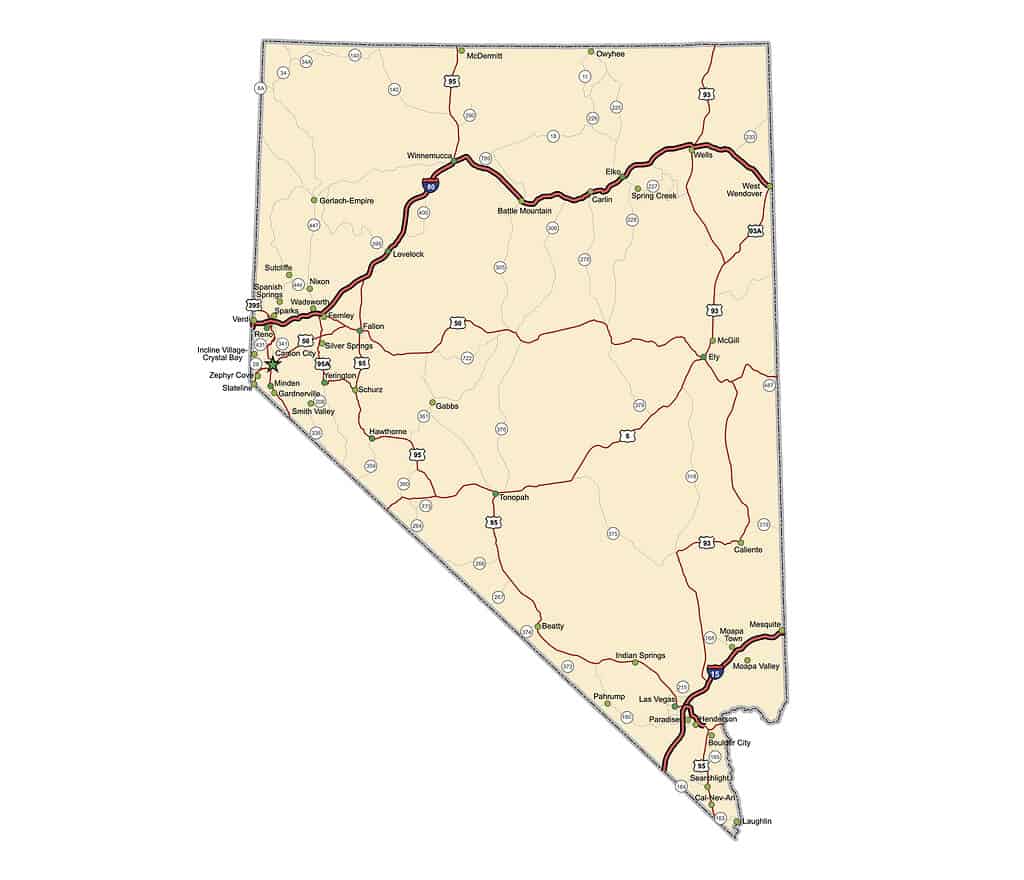For thousands of years flags have been used to represent places, groups, and monarchies. Although they might appear as nothing more than brightly colored symbols at first glance, in many cases they actually have a much deeper meaning. This is because flags can tell a tale of the history of a place, represent war or peace, or even act as a beacon of hope depending on the situation.
But what does the flag of Nevada represent? Join us as we learn about its history and meaning, as well as discover the previous state flags.
About Nevada

Nevada is a landlocked state in the Western United States
©iStock.com/jamirae
Nevada is a landlocked state in the western region of the US. Although it is well known for its largely desert landscape it also has several mountain ranges, including part of the Sierra Nevada mountain range. The highest point in the state is Boundary Peak at 13,147 feet which is part of the White Mountains. Nevada’s name itself is the Spanish word for snowy because of the snow covering the mountains in winter.
Historically, Nevada was inhabited by many native American tribes. The first European explorers didn’t arrive until the 1770s, with the Spanish Francisco Garcés being the first. Nevada was initially annexed to Spain as part of the Spanish Empire. However, it became part of Mexico following the Mexican War of Independence in 1821.
The land eventually came under the ownership of the US in 1848 after the Mexican-American war. Following this Nevada then formed part of the Utah Territory. However, after silver was discovered at Comstock Lode in 1859 the population of the area dramatically increased. It was then decided in 1861 to separate the area into its own Nevada Territory.
Nevada officially became the 36th US state in 1864 even though its population was not much more than 10,000 at the time. This was significantly less than the 60,000 people that were usually required for an area to become a state. There were two reasons for this. One was that Nevada’s significant mining industry would be a boost to the already industrialized Union. The other reason was that it was hoped that the addition of Nevada would help to secure Abraham Lincoln’s re-election the following week.
Previous Flags of Nevada

The current flag of Nevada has been used since 1991 and features the words “battle born.”
©iStock.com/Kamlesh Suthar
Since it became a state in 1864, Nevada has had three former state flags. The first flag was designed by Governor John Sparks and Colonel Harry Day in 1905 and was in use for ten years until 1915. It consisted of a dark blue field with the words, “silver, Nevada, and gold” divided by rows of silver and gold five-pointed stars. There were 36 stars on the flag in total to represent Nevada being the 36th state to join the Union. The use of the words silver and gold along with the colors represented the large amount of silver and gold that could be found naturally in the state.
The second flag again featured 36 stars – 18 gold and 18 silver – and was designed by Clara Crisler. As well as the stars it featured the state seal in the center with the state name above it and the state motto “All for our country” below. The state seal featured images that represented important aspects of Nevada – such as mining and agriculture. Although this flag remained in use until 1929 many people felt that the design was too complex.
The third flag originated as the winning design in a 1926 contest and was created by Louis Shellback III. However, due to state officials deciding to change some aspects of it, it was not used until 1929. It featured a sagebrush wreath at the hoist side surrounding a silver five-pointed star with the words, “battle born” above. It also featured the name of the state arranged in a circle around the star. “N” was at the top of the upper point of the star and the remaining letters were situated in the spaces between the points in a clockwise arrangement.
History of the Flag of Nevada
The current flag of Nevada was adopted in 1991 and is an adaptation of Louis Shellbeck’s design. One of the reasons that his original design had taken three years to be adopted was that there had been a disagreement between state officials as to the placement of the name of the state on the flag.
Although the design featuring the name positioned in a circle around the star remained in use from 1929 until 1991 it was eventually decided that it needed to be changed. This is because a state researcher noticed in 1989 that the position of the name did not accurately match up to the 1929 legislation about the flag. Therefore, in 1991 the position of “Nevada” on the flag was changed to reflect the original agreement. This new change placed the name of the state below the star but still within the sagebrush wreath.
Symbolism and Meaning

Nevada’s population continues to grow at a rapid rate in the 21st century.
©iStock.com/Oleksii Liskonih
The flag of Nevada has a simple design compared to some of the other state flags. However, it still manages to accurately represent some of the state’s history. For a start, the silver star again represents the silver deposits in the state. In fact, Nevada’s nickname is the “Silver State” because of the importance of silver in the state. Furthermore, the wreath is made from sagebrush which is the state flower.
Finally, the words “battle born” represent the fact that Nevada officially became a state during the Civil War. In 1864 Nevada is one of only two states to join the Union during the Civil War. The first was West Virginia in 1863.
Up Next
- Every Flag in the World: Photos, History, and More
- The Flag of Alaska: History, Meaning, and Symbolism
- The Flag of Arizona: History, Meaning, and Symbolism
The photo featured at the top of this post is © iStock.com/Oleksii Liskonih
Thank you for reading! Have some feedback for us? Contact the AZ Animals editorial team.






